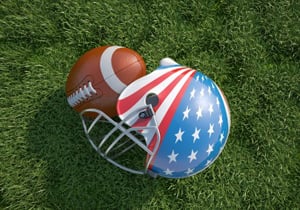
Football helmet companies make attempts to avoid future athletes’ injuries and lawsuits:
The topic of traumatic brain injuries (TBI) in sports has recently become a very pressing issue. Most notably, the occurrence of concussions in the sport of football has been surfacing and played out more and more in our nation’s courtrooms. In light of the growing liability issues associated with football head injuries and the NFL’s recent $765 million settlement for former NFL players, an article in the NY Times addressed the warning label language that football helmet makers include on their products.
Schutt Sports and Rawlings, two helmet manufacturers, contain warning labels on all of their football helmets that state: “No helmet system can protect you from serious brain and/or neck injuries including paralysis or death. To avoid these risks, do not engage in the sport of football.”
Riddell, the company that makes football helmets for the National Football League (NFL) – which also happens to be the largest maker of helmets in the United States, does not include the language suggesting players should opt out of the sport. In fact, both the NFL and Riddell were named as defendants in a recent lawsuit filed by 4 former NFL players for personal injuries due to traumatic brain injuries. Furthermore, as reported by The Washington Times, the family of Derek Sheely, a Frostburg State University football player in Maryland, filed a wrongful death lawsuit against the NCAA, his coaches and the helmet maker – Schutt Sports. Derek Sheely collapsed and died in 2011 after taking part in alleged prolonged and intense ‘helmet-to-helmet’ drills.
Purpose of the warnings:
Both the NFL and the National Collegiate Athletic Association (NCAA) have increasingly been at the center of head injury lawsuits. Therefore, some football helmet makers have taken it upon themselves to increase awareness of the dangers of playing football.
Do these football helmet makers really want players to stop playing football? Probably not. However, these manufactures recognize that although there is a risk of harm in anything one may participate in – when it comes to football, the risk factor is inherently more dangerous due to the nature of the game.
The purpose of these warnings is to make consumers aware of the risks involved. Reducing the risk of injuries in football is a more realistic goal than total injury prevention. By warning players, coaches, and parents of the dangers involved in the sport and also increasing awareness about concussions and what steps to take in the event of such an injury – the risk may be reduced.
What is a concussion?
The Centers for Disease Control and Prevention (CDC) defines a concussion as a kind of TBI that is, “…caused by a bump, blow, or jolt to the head that can change the way your brain normally works.”
The Mayo Clinic describes the brain’s make-up as a gelatin-like substance. Inside the skull, the brain ‘floats’ in the cerebrospinal fluid. This fluid protects the brain from typical daily bumps that an individual may experience. However, a violent blow to the head or upper body may cause the brain to ‘hit’ the inner wall of the skull - resulting in a concussion.
Often, concussions occur while individuals play sports. Concussions can occur while playing any sport. The CDC summarizes the details of concussions as follows:
- Concussions are brain injuries – all of which are serious.
- Loss of consciousness is not the norm with concussions.
- Proper response is crucial – the ability to recognize a concussion and respond accordingly to concussions at their onset can prevent additional injury and even prevent fatalities.
The ‘bump’ or contact to the head does not have to be a hard hit to cause serious injury. A serious TBI can even happen without direct contact to the head. For instance, if a person’s body is struck and the blow to the person’s body causes his or her head to quickly jerk backwards and forwards – a concussion may ensue.
Recognizing and responding to concussions:
The CDC lists concussion-warning signs for coaches, parents and others on the sidelines to look for in athletes so that additional injuries may be avoided. Two factors that raise a red flag that an athlete has a potential concussion include:
- The athlete experiences a blow to the head or body wherein the head moves back and forth in a rapid fashion; and
- The athlete’s demeanor – mental or physical – changes.
Should an athlete experience any of the warning signs – it is imperative that he or she discontinues play and be seen by a qualified medical professional who will be able to determine when and if, the individual can return to athletic activities.
Legal recourse for head injuries:
The risk of suffering a TBI exists when playing football regardless of the warning label on any football helmet. If you or a loved one suffered from a TBI and want to explore legal options, it is important to contact an attorney who specializes in traumatic brain injury.



